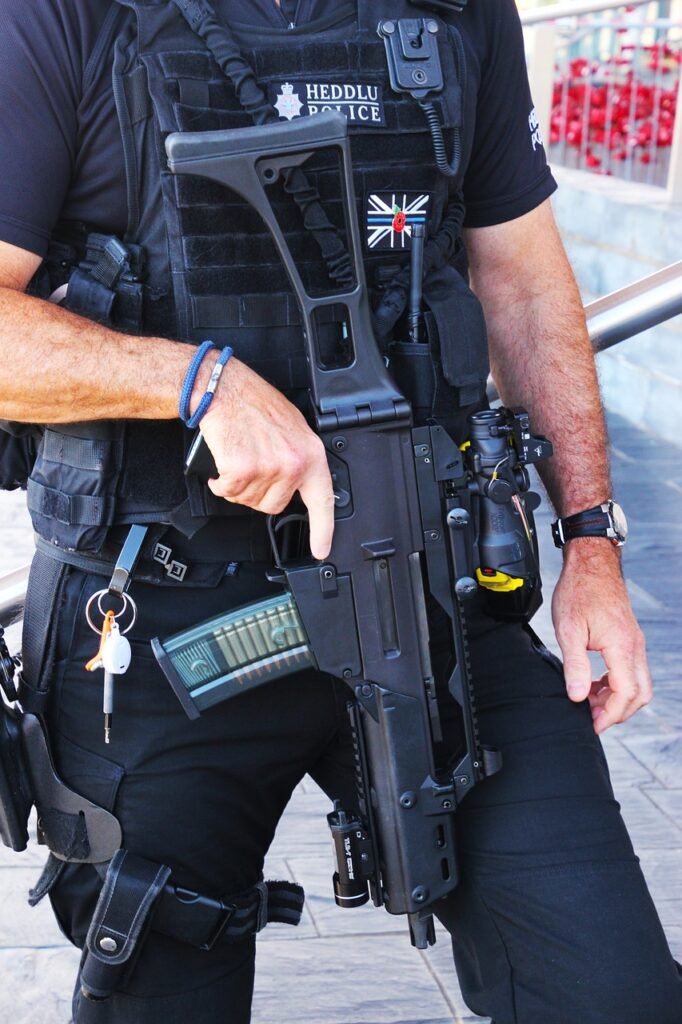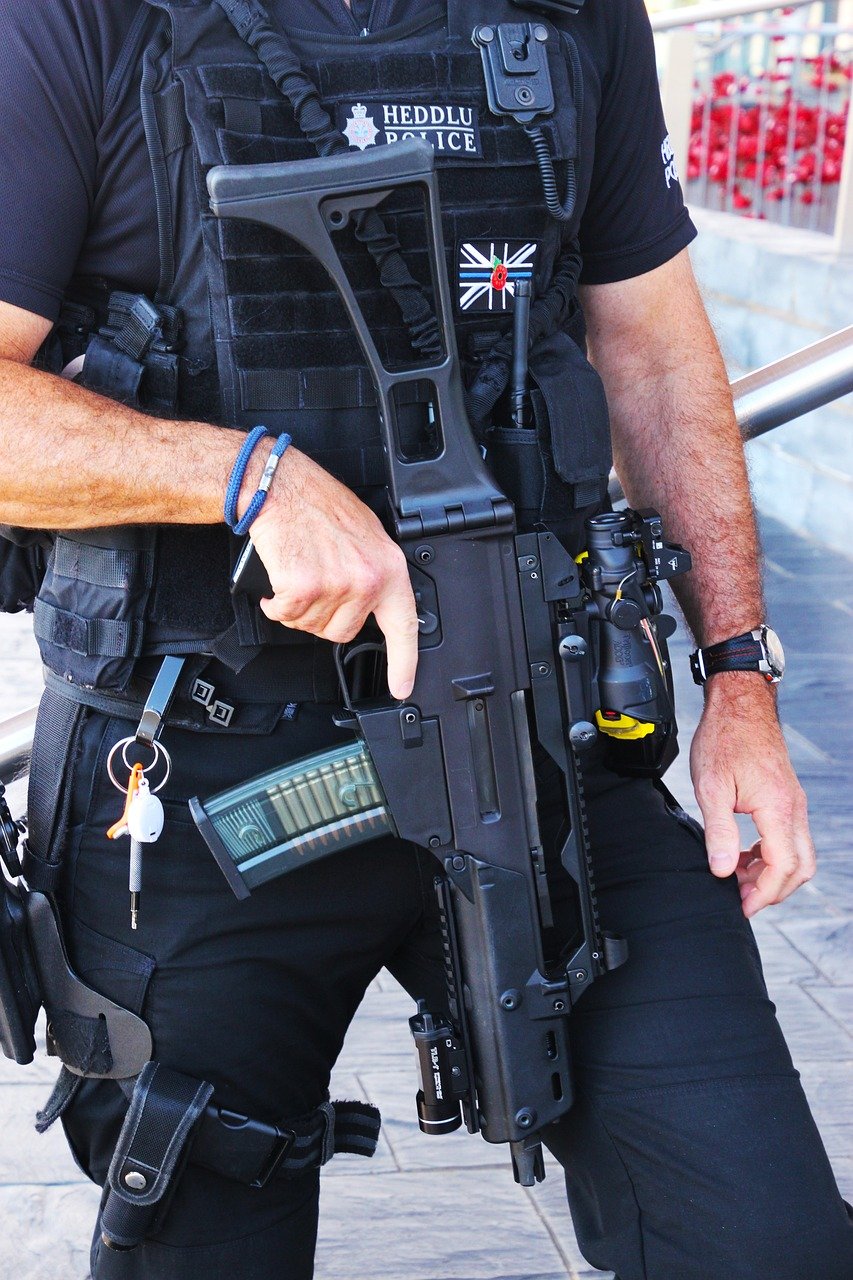Are you an avid shooter, or maybe just starting out and looking to improve your skills? Whatever your level of experience, it is essential to recognize the importance of firearm safety at ranges. From handling the weapon correctly to knowing the range rules, adopting safe shooting practices can not only protect yourself but also others around you. In this article, we will explore the various aspects of firearm safety at ranges and provide valuable tips to ensure a safe and enjoyable shooting experience.

This image is property of pixabay.com.
1. Understanding Firearm Safety
Firearm safety is of utmost importance when it comes to handling guns. Whether you are a seasoned shooter or a beginner, it is crucial to have a good understanding of the basic firearms safety rules. These rules serve as the foundation for safe shooting practices and help prevent accidents and injuries.
1.1 Four Basic Firearms Safety Rules
The four basic firearms safety rules are as follows:
-
Always treat every firearm as if it is loaded. Never assume that a firearm is unloaded, even if you just unloaded it yourself. Handling a firearm with this mindset ensures that you take the necessary precautions and avoid negligent actions.
-
Keep your finger off the trigger until you are ready to shoot. Your trigger finger should rest outside the trigger guard until you have properly aimed at your target and made the decision to fire. This prevents accidental discharges and maintains control over the firearm.
-
Never point the firearm at anything you do not intend to shoot. Always be mindful of the direction the muzzle is pointing. Keep it pointed in a safe direction, away from yourself and others, even when the firearm is unloaded.
-
Be aware of your target and what lies beyond it. Before firing, ensure that you have a clear line of sight to your target and that there are no unintended obstacles or people in the backdrop. This prevents unintentional damage or harm to bystanders or property.
1.2 Importance of Following Safety Rules
The importance of following these safety rules cannot be stressed enough. They are designed to keep both shooters and those around them safe. By adhering to these rules, you significantly reduce the risk of accidents and injuries.
Following safety rules also promotes responsible gun ownership. By demonstrating your commitment to safety, you set a positive example for others and contribute to a culture of responsible firearms use.
1.3 Responsibility of Every Shooter
Every shooter has a responsibility to prioritize safety. It is not only the range officials or instructors who are responsible but also every individual handling a firearm. Safety is a collective effort, and every shooter should actively participate in maintaining a safe shooting environment.
This responsibility includes not only following safety rules but also being vigilant and observing good safety practices at all times. By doing so, you not only protect yourself but also your fellow shooters, and contribute to an overall safe and enjoyable shooting experience.
2. Importance of Firearm Safety at Ranges
When it comes to firearm safety, ranges play a significant role. They provide controlled environments for shooting and offer various amenities and resources to ensure a safe shooting experience. Understanding the importance of firearm safety at ranges is crucial in minimizing accidents and injuries.
2.1 Potential Risks and Hazards
Ranges can present potential risks and hazards due to the nature of shooting activities. The discharge of firearms and the presence of numerous shooters in close proximity create an environment where safety precautions are essential.
Risks and hazards at ranges can include things like accidental discharges, ricochets, and unsafe handling of firearms. These risks can be mitigated through proper adherence to safety rules and range-specific protocols.
2.2 Minimizing Accidents and Injuries
The implementation of proper safety measures at ranges is key to minimizing accidents and injuries. Range officials and staff play a crucial role in enforcing safety rules and regulations. They oversee the safe conduct of shooting activities, ensure compliance with range rules, and provide guidance and support to shooters.
By following range rules and exercising caution, shooters can actively contribute to a safer environment. This includes being mindful of their actions, attending safety briefings, and seeking assistance when needed. It is important to remember that every individual has a role to play in maintaining a safe shooting range.
2.3 Protecting Yourself and Others
By prioritizing firearm safety at ranges, you not only protect yourself but also others. Adhering to safety practices and rules helps create a secure environment for everyone involved. It is everyone’s responsibility to be aware of their surroundings, communicate effectively, and report any safety concerns or incidents promptly.
Remember, the goal is to enjoy shooting sports while ensuring the well-being of all individuals present. Protecting yourself and others should always be at the forefront of your mind when on the range.

This image is property of pixabay.com.
3. Safe Handling of Firearms
Safe handling of firearms is vital to prevent accidents and injuries. Understanding and implementing proper handling techniques helps maintain control over the firearm and reduces the risk of unintentional discharges.
3.1 Treating Every Firearm as Loaded
Regardless of whether you believe a firearm is unloaded or not, always treat it as if it is loaded. This mindset keeps you cautious and focused on following the necessary safety protocols. Treating every firearm as loaded means never engaging in careless behaviors and always handling the firearm with care and respect.
Even if someone else hands you a firearm, take the time to visually and physically inspect it to confirm its condition. This practice should become second nature to every responsible shooter.
3.2 Muzzle Control and Finger Placement
Maintaining proper muzzle control and finger placement are crucial aspects of safe firearm handling. Always keep the muzzle pointed in a safe direction, away from yourself and others, even when the firearm is unloaded.
Your trigger finger should remain outside the trigger guard until you are ready to shoot. This prevents accidental discharges and ensures that you have complete control over the firearm at all times.
3.3 Proper Unloading and Clearing Procedures
Before handling a firearm, it is important to familiarize yourself with its specific unloading and clearing procedures. Different firearms may have different mechanisms and steps involved in unloading them. Reading the manufacturer’s instructions and seeking professional instruction can help you understand the specific procedures for the firearms you will be handling.
Always ensure that the firearm is unloaded and no ammunition is present before performing any maintenance or storage activities. Following proper unloading and clearing protocols is essential for safe handling and storage of firearms.
4. Range Rules and Etiquette
Range rules and etiquette are critical for maintaining a safe and respectful shooting environment. Familiarizing yourself with range rules, respecting commands and range officials, and using range equipment properly are essential components of safe shooting practices.
4.1 Familiarizing Yourself with Range Rules
Before stepping onto a shooting range, take the time to familiarize yourself with the range’s specific rules and regulations. Every range may have its own set of rules, which can include guidelines for firearms handling, shooting procedures, and general range conduct.
Understanding and adhering to these rules demonstrates your commitment to safety and ensures that everyone on the range can enjoy a secure and organized shooting experience.
4.2 Respecting Commands and Range Officials
Range officials and commands exist to maintain safety and order on the range. It is important to listen carefully and comply with any instructions or commands given by range officials. They are trained to oversee shooting activities and have the authority to address any safety concerns or issues.
Respecting range officials and their commands helps create a cohesive and harmonious shooting environment. It is essential to be responsive and cooperative in order to ensure the well-being and enjoyment of all shooters.
4.3 Proper Use of Range Equipment
Ranges provide various equipment and facilities to enhance the shooting experience. When using range equipment, such as target holders or shooting benches, it is important to use them responsibly and according to their intended purpose.
Improper use of range equipment can pose safety risks to yourself and others. Always follow any usage guidelines provided by the range and report any equipment malfunctions or damage to range officials.

This image is property of pixabay.com.
5. Eye and Ear Protection
The use of proper eye and ear protection is essential when engaging in shooting activities. Protecting your vision and hearing is critical to prevent long-term damage and ensures your overall safety.
5.1 Understanding the Importance of Protection
Firearms produce loud noises and can create high-velocity particles that may be harmful to the eyes. Without proper protection, you expose yourself to these potential risks. Using eye and ear protection acts as a barrier, shielding you from the effects of these hazards.
5.2 Types of Eye and Ear Protection
There are various types of eye and ear protection available to suit individual preferences and shooting activities. Safety glasses or goggles with impact-resistant lenses are the most common forms of eye protection. They should be worn at all times when handling or shooting firearms.
For ear protection, options include earplugs, earmuffs, or electronic earmuffs that allow normal conversation while dampening loud noises. Find the type of protection that works best for you and prioritize wearing them consistently.
5.3 Inspecting and Maintaining Safety Gear
Regularly inspecting and maintaining your eye and ear protection is crucial to ensure its effectiveness. Check the condition of your safety glasses or goggles for any signs of damage or wear. Replace them if necessary.
Similarly, inspect your ear protection for any tears or signs of deterioration. Clean them regularly according to manufacturer guidelines and replace them if they become damaged or lose their effectiveness.
By routinely inspecting and maintaining your safety gear, you can trust that it will provide the necessary protection when you need it most.
6. Firearm Malfunctions and Misfires
Understanding and being prepared for firearm malfunctions and misfires are important for safe shooting practices. Recognizing common malfunctions, knowing the proper response, and avoiding negligent discharges are essential components of firearm safety.
6.1 Recognizing Common Malfunctions
Firearm malfunctions can occur due to various factors, such as ammunition issues or mechanical failures. Recognizing the common types of malfunctions, such as failure to feed, failure to eject, or failure to fire, is critical for addressing them safely.
Training and experience can help you develop the knowledge and skills to identify these malfunctions and respond accordingly. Seeking professional instruction and regularly practicing different scenarios can enhance your ability to handle malfunctions safely.
6.2 Proper Response to Malfunctions
When a malfunction occurs, it is important to respond calmly and follow proper procedures. Depending on the type of malfunction, the appropriate response may involve tapping the magazine, racking the slide, or performing a clearance drill.
Always refer to your firearm’s manufacturer instructions and seek professional guidance on the specific procedures for your firearm. Practicing malfunctions drills regularly in a controlled environment can help you develop the necessary skills and muscle memory to handle malfunctions effectively.
6.3 Avoiding Negligent Discharges
Negligent discharges occur when a firearm is discharged unintentionally due to mishandling or carelessness. To avoid negligent discharges, adhere to the basic firearms safety rules at all times and handle your firearm with utmost care and respect.
Never point the firearm at anything you do not intend to shoot, keep your finger off the trigger until you are ready to shoot, and treat every firearm as if it is loaded. By following these rules and adopting responsible handling practices, you significantly reduce the risk of negligent discharges.
7. Safe Loading and Unloading Procedures
Proper loading and unloading procedures are essential for safe firearm handling. Following manufacturer instructions, double and triple checking ammunition, and securely storing ammunition are key components of safe loading and unloading.
7.1 Following Manufacturer Instructions
Firearms have specific loading and unloading procedures outlined by their manufacturers. It is important to familiarize yourself with these instructions and follow them carefully. Different firearms may have varying mechanisms and steps involved in loading and unloading.
Taking the time to read and understand the manufacturer instructions ensures that you handle your firearm correctly and safely. When in doubt, seek professional instruction or consult an experienced shooter.
7.2 Double and Triple Checking Ammunition
Before loading a firearm, it is crucial to double and triple check your ammunition. Ensure that you are using the correct type and caliber of ammunition for your firearm. Mistakenly loading the wrong ammunition can have severe consequences.
Carefully inspect each round of ammunition for signs of damage or defects. Discard any ammunition that appears questionable. By being diligent in checking your ammunition, you reduce the risk of malfunctions or catastrophic failures.
7.3 Securely Storing Ammunition
Properly storing ammunition is an important aspect of safe firearm ownership. Ammunition should be stored in a cool, dry place away from heat sources or moisture. Use appropriate storage containers or safes specifically designed for ammunition.
Ensuring that your ammunition is stored securely not only prevents accidental access by unauthorized individuals but also minimizes potential hazards, such as fires or explosions. By taking responsible measures to store your ammunition safely, you contribute to a secure shooting environment.
8. Shot Placement and Target Selection
Making informed decisions about shot placement and target selection is crucial for safe shooting practices. Aiming for safe backstops, avoiding dangerous target setups, and identifying potential ricochet areas are essential components of shot placement and target selection.
8.1 Aiming for Safe Backstops
When shooting, it is important to aim at targets with safe backstops. A safe backstop refers to a solid barrier or a designated area that can stop or contain the bullets safely. Backstops should be capable of preventing bullets from traveling beyond the intended shooting area.
Avoid shooting at targets that do not have suitable backstops, such as trees, rocks, or bodies of water. By aiming for safe backstops, you minimize the risk of stray bullets causing harm or damage.
8.2 Avoiding Dangerous Target Setups
Creating a safe target setup is crucial to prevent accidents and injuries. Avoid setting up targets in a manner that may cause bullets to ricochet unpredictably. Ensure that there is a clear and unobstructed shooting lane to your target.
Do not use targets that are too close to hard surfaces, as bullets can bounce back or fragment upon impact. Furthermore, avoid targets that are placed at angles that may cause bullets to deflect in unintended directions.
8.3 Identifying Potential Ricochet Areas
Ricochets occur when a bullet strikes a surface at an angle and deflects in a different direction. It is important to be aware of potential ricochet areas during shooting activities. Surfaces like concrete, steel, or hard-packed soil can cause bullets to ricochet.
By identifying potential ricochet areas, you can take appropriate precautions, such as adjusting your shooting position or selecting different target setups. Being mindful of ricochet risks contributes to a safer shooting experience for all.
9. Communication and Emergency Protocols
Establishing effective communication, reporting safety concerns or incidents, and being knowledgeable about emergency first aid and evacuation procedures are vital for maintaining a safe shooting environment.
9.1 Establishing Effective Communication
Communication is key to maintaining safety on the range. Establishing effective communication among shooters, range officials, and staff is important for swift and appropriate response to any safety concerns or incidents.
When on the range, use verbal cues, hand signals, or designated communication procedures to convey information or address potential safety issues. Clear communication enhances situational awareness and ensures a coordinated approach to safety.
9.2 Reporting Safety Concerns or Incidents
If you observe any safety concerns or incidents on the range, it is crucial to report them promptly. Notify range officials or staff immediately, providing them with accurate and detailed information about the issue.
Reporting safety concerns or incidents helps prevent further risks and allows for timely intervention or investigation. Remember, every shooter has a responsibility to maintain the safety of the range and its participants.
9.3 Emergency First Aid and Evacuation
Being knowledgeable about emergency first aid and evacuation procedures is essential for handling potential injuries or emergencies on the range. Familiarize yourself with basic first aid techniques, such as controlling bleeding, administering CPR, or dealing with shock.
Additionally, acquaint yourself with the layout and accessibility of emergency exits and evacuation routes. By being prepared for potential emergencies, you can respond effectively and provide immediate assistance until professional help arrives.
10. Continual Education and Practice
Firearm safety is an ongoing process that requires continual education and practice. Recognizing the importance of regular training, seeking professional instruction, and participating in competitions or drills are integral aspects of maintaining a high level of safety.
10.1 Importance of Regular Training
Regular training helps to reinforce proper safety procedures and improve shooting skills. By regularly practicing safe handling techniques, you develop muscle memory and ensure that safety practices become second nature.
Participating in training programs or courses specifically designed to enhance firearm safety can further expand your knowledge and proficiency. Treat every training session as an opportunity to improve your skills and deepen your understanding of safe shooting practices.
10.2 Seeking Professional Instruction
Seeking professional instruction is invaluable for enhancing your firearms knowledge and skills. Professional instructors possess the expertise and experience necessary to guide you through safe and effective shooting techniques.
Enrolling in courses or workshops offered by reputable instructors helps you gain valuable insights into safe firearm handling, range protocols, and marksmanship. Regularly seeking professional instruction allows you to stay updated on the latest safety practices and refine your shooting abilities.
10.3 Participating in Competitions and Drills
Participating in shooting competitions and drills provides practical experience and enhances your ability to handle firearms safely in high-pressure situations. Competitions and drills simulate real-life scenarios and foster the development of critical skills such as target acquisition, decision making, and efficient execution.
By regularly engaging in these activities, you challenge yourself to apply safe shooting practices while improving your overall proficiency. Competitions and drills also offer opportunities to learn from experienced shooters, exchange best practices, and further reinforce the importance of firearm safety.
In conclusion, understanding and implementing firearm safety practices are essential for all shooters. By adhering to the four basic firearms safety rules, prioritizing safety at ranges, handling firearms responsibly, abiding by range rules and etiquette, using proper eye and ear protection, being prepared for malfunctions and misfires, following safe loading and unloading procedures, and making informed decisions about shot placement and target selection, you can ensure a safe and enjoyable shooting experience. Remember to communicate effectively, report safety concerns or incidents promptly, familiarize yourself with emergency protocols, and continually educate yourself through regular training and seeking professional instruction. By prioritizing firearm safety, you contribute to a culture of responsible firearms use and create a secure environment for yourself and others on the range.
